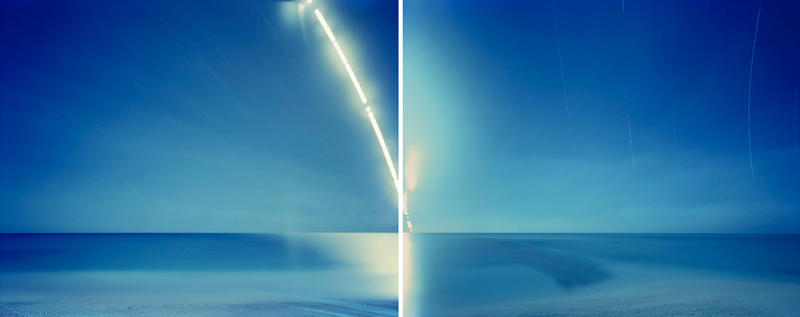I should start by saying that this review is long overdue. This is partly due to the fact that my blogging activity has ground to a halt of late, but also because of Memory Traces itself. The book is an intimidating object consisting of one oversized (30.5 x 41 cm) volume weighing in at a hefty 202 pages accompanied by two smaller books, ‘Höffding Step’ and ‘Dark Star’, inset into a custom cardboard case. Memory Traces is not only intimidating but unwieldy. This is not a book that can be casually flicked through: it requires space (if only to support its weight and size) and time to get through its complex layout made up of gatefolds and double-gatefolds of different sizes. Its three-book structure is also complex and of course there is no easy instruction manual provided to tell you how to get started. However, while these first observations may come across as criticisms, it is precisely because Memory Traces is such a difficult book that it is so unique.
The central book in the trilogy consists of a series of large format landscape photographs that were made in Sarajevo; Hiroshima and Nagasaki; Berlin, Bitterfeld-Wolfen and Ronneburg; Bikini Island and Nam Island; Chernobyl; Khe San and My Lai. These images all depict places that have been deeply affected by recent man-made conflicts or disasters. However, Markerink's images are far removed from the inflated drama of what has become known as 'ruin porn'. His photographs of Sarajevo, My Lai or Chernobyl reveal places that seem to be defined by the scars of their past. As the Japanese photographer Shomei Tomatsu said of Nagasaki, these are places where it seems as if "time has stopped". Memory Traces also depicts landscapes, such as those of Hiroshima or Berlin, that show few visible signs of past traumatic events. Although these cities are still defined in many ways by their history, their landscapes are in the process of being radically transformed by the objectives of economic growth.
You could say that Memory Traces deals with the different ways that history manifests itself within the landscape. However, it is as concerned with the present and the future as with the past. One of the most remarkable things about the imagery in this book is its treatment of time: the locations that Markerink has photographed all have troubling pasts, but these images do not give the sense of looking back. Instead they raise questions of how the past is carried forward and transformed as time passes. Although it is made up entirely of landscape photographs, this is fundamentally a book of big ideas. Markerink is not interested in the formal aspects of landscape, but rather in how landscape acts as a mirror for culture, for society in general. In 'Höffding Step', a book of text combining travel diaries, reflections on contemporary culture with Markerink's views on the changing nature of photography, Memory Traces reveals itself to have even greater and broader aspirations.
With Memory Traces, Markerink has created an object that is designed to create the space for us to stop and think, a space that is essential when dealing with such ambitious subjects. Everything about the way it is made — the book's huge size, its use of gatefolds, etc. — seems to be designed to slow down the reading process as much as possible. This is a book that also made me think about the way that we read photobooks. To use Markerink's own description, Memory Traces is an "experience" with many entry and exit points rather than a book that can simply be read from start to finish.
If all of this sounds a little lofty, that is because it is: I doubt that you will ever come across a more ambitious photobook. It is a project that Markerink worked on for over 10 years, one which he describes as a gift he decided to make to himself for his 50th birthday "as a means to come to terms with (his) culture and (his) position within it." It is a book that swims directly against the current of these times in which images are made, distributed and consumed and discarded in a matter of seconds. It will most likely bewilder you, frustrate you, confuse you and probably keep you coming back for more. Like Terence Malick's Tree of Life, it is not without its flaws, but it is rare to come across projects that are this outrageously ambitious and for that alone Memory Traces is worth seeking out.
Cary Markerink, Memory Traces. Ideas on Paper (self-pub., clothbound hardcover, 30.5 x 41 cm, 202 pages together with two small booklets, 'Höffding Step' and 'Dark Star' 12 x 16 cm in a printed box, 2009).
Rating: Highly Recommended



